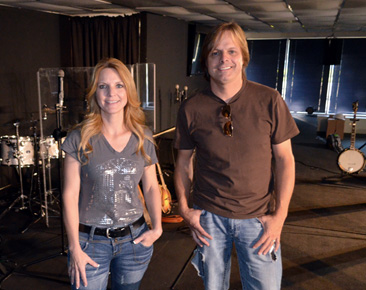Lee and Elaine Roy talked about their roots, milestones and their current success just before an October 18 performance at Faith City in Titusville, FL, less than 15 miles as the crow flies from the launch pads at Kennedy Space Center.
Just what that ‘business’ is doesn’t need a name or a pidgeonhole to fit in, it’s the music and the connection with the audience that’s most important, they say.
The common musical thread, whether originals or cover songs, is that its roots are traditional, calling back memories of the pure songs in Americana of yesteryear: the old songs still echoing with many of us that remain the soul of both country and bluegrass.
“The best advice that we ever got was that the best thing we could do with our career is to bring new music to the genre,’’ Lee said.
The Roys say they are proud to be able to offer more of those familiar and pure sounds, set in the current time, and take pride in the content of the message they put out. One day, Lord willing, their songs may become standards although they are way too humble to ever say so.
The Roys love traditional bluegrass and appreciate it’s musicianship, but they took a slightly different path. They chose to branch out to the more ballady end of bluegrass – you could even call it country – as a means to tell their stories, Lee said.
“We’re not 160-beats a minute, 10 songs in a row,’’ Lee said.
Added Elaine: “We’re doing the music that is really, truly in our heart and soul, stuff that we want to write about. I have always been a story person, that’s why I like Dolly Parton. If you look at her songs, there are a lot of stories in there,” said Elaine.
Lee said the country v. bluegrass debate seems to come up a lot with The Roys.
“We played Bean Blossom last year for the first time and everybody told us ‘Oh my gosh, you’d better rip out some old traditional stuff.’ I told the band that we are going to do our set. I figured I had one chance to either alienate the crowd or make the crowd our new fans. They told us we’ll be back next year and that they appreciated the fact that they didn’t hear Little Cabin Home on the Hill for the 15th time.’’
Moving to Nashville from Fitchburg, MA has turned out to be successful path to stardom for The Roys, but they admit that Music City was a bit intimidating at first.
“We’ve been their eight years now. It’s pretty awesome. I think when you get there you find the scope of it. You say ‘that’s a great player, that’s a really great player and that’s a really, really great player. It’s a pretty amazing town with a lot of talent and the networking is what really got it going for us: going to writer’s rounds and writing with different people. It’s no different than if you go to LA for acting or New York City for Broadway. I love it. It’s got everything you need without it being too big,’’ Lee said.
Their first big break was guest appearances with Country legend George Jones.
“It was a friend of ours that knew George, and their booking agent and they kind of pitched us. We had a song that we re-recorded called Grandpa’s Barn, and they really liked that song. We got to do a few shows, then a few more and a few more. Sometimes we’d meet up with them on a Friday and we wouldn’t see them for two weeks and then we’d do a whole weekend with them,” Lee said.
Career highlights seem too numerous to count, but Elaine says that each one is a special milestone.
“There’s been many. We’ve won awards I never thought we would win and we sang on the Grand Ole Opry November 1st. That was like the pinacle. We’ve always wanted to sing on the Grand Ole Opry. We’ve sung in Bogata, Columbia, South America with Compassion International singing for underprivileged children. Our music has brought us to many many places that we never, ever thought we’d go: Australia, Europe.”
“When you start this you have dreams and hopes and aspirations. You never know what the Good Lord has in store,” she said.
As for the future, it seems the sky is the limit for The Roys, but they make a big effort to keep things in perspective.
“I think you always want to grow your career and keep it moving in the right direction. You start out with a list, like I want to win a Grammy. That’s all great, but honestly I just want to be happy because the day that music doesn’t make me happy, I’ll go get a job somewhere. For me, you want to get the recognition from your peers, but I just want to keep playing music and making music that’s fun to play, and surrounding ourselves with great players that want to play with us and want to play the music we play. You have to have a good team.
“In all honesty, if my career goes no higher, as long as I can pay my bills, I’m happy,’’ Lee said.
And The Roys are happy that their new songs can in some small way reach deep like the great songs of the past that remain in the heart of rural America.
“At the end of the day someone comes up and says ‘you made me cry,’ I’m like ‘awesome.’ At least we evoked some kind of emotion,’’ Lee said.
